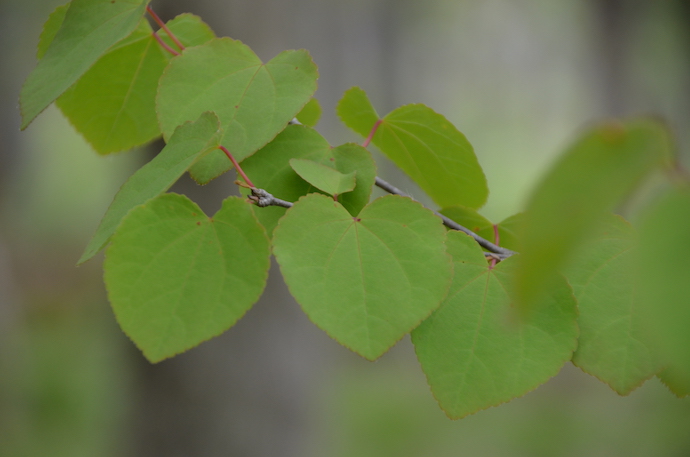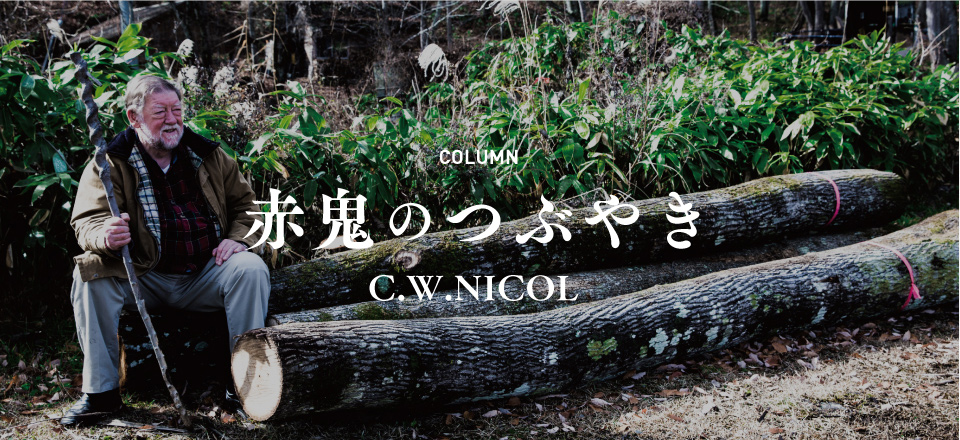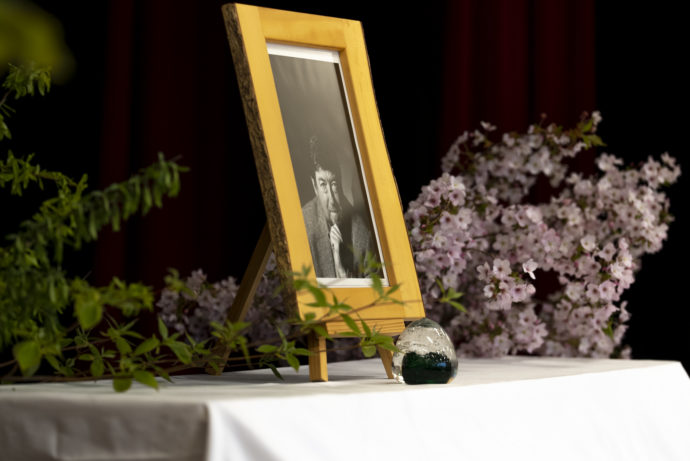Column
【赤鬼のつぶやき C.W.ニコル】カツラ(KATSURA)


アファンの森は、25年前は沼地でとても水はけの悪い場所でした。そのため水分を貯める力のある落葉樹を植えることになって、選んだのがカツラです。英語の一般的な呼称はないのですが、学名はCercidiphyllum japonicaです。日本と中国に生育していて、どんどん、よく育つのが特徴です。想定していた通り、ほどよく湿気を吸収してくれるうえ、暑い真夏でも涼しくて心地よい木陰をつくってくれる「森」へとあっという間に成長し、ウッドチップを敷いて小道を作りました。
アファンの森保全担当の石井さんは、今年、密集しすぎてしまったカツラを半分ほど伐りました。カツラの木材を何かに使おうとしているのかまだ聞いていませんが、碁盤はカツラから作ると耳にしたことがあります。軽くて、やわらかく密な素材は、箱などや家具にもぴったりです。

春、ハート形の葉が、紫がかかった赤に変わる様子はとてもかわいらしいです。そして夏には明るい緑になります。秋は、バターのような黄色やピンク、オレンジなどに黄葉して、キャラメルのように優しく甘く香ります。そして木の幹は、灰色がかった茶色で、毛羽立ちがあります。もし種を採りたいのなら、雌雄の個体を揃えて植えておかなくてはなりません。種は、小さくて羽が付いています。これまで、カツラの種を鳥が食べる現場を見かけたことはありません。
45メートル級の巨樹になることも珍しくなく、大きく成長します。いくら見上げても、てっぺんが見えないほど大きいカツラがアファンの森にはあります。これを植えたときに、こんなふうに大きくなって欲しいと想像していた通りになりました。大きくなりすぎて、石井さんが伐採してしまったほどですから。このまま二千年は生き続けると言われています!
北米の公園には、在来の種ではありませんが、甘い匂いも、優しい木陰が好まれてカツラがたくさん植えられています。害虫や菌にも強いうえ、雪が積もる冬も、高温の夏でもわたしたち人間と一緒に耐え抜くので、カナダのトロントやウィニペグでもカツラが繁殖しているところがあるほどです。北米ではカツラの化石が見つかっているので、古代から生育していたはずですが、在来の種類は何世紀も前に絶滅してしまいました。アメリカの人びとは日本のカツラを故郷に持ち帰り、種から殖やして植えたのです。そして北米の人々からも広く愛される存在になっています。
2017年5月
C.W. ニコル
写真提供:C.W.ニコル・アファンの森財団
KATSURA

About 25 years ago one section of our Afan woods was very boggy and difficult to drain. We decided to plant deciduous trees that would suck up moisture from the ground and chose Katsura. There is no English name for this tree, but its scientific name is Cercidiphyllum japonica. The Katsura tree is native to Japan and China. The trees grew very well and soon we were able to lay a wood chip path through their grove, because they did what we thought they would, and sucked up moisture, making the little Katsura grove cool and pleasant on the hottest summer days.
This year Mr. Ishii, our forester, cut half of the Katsura trees because they were getting too crowded, I haven’t asked him what he will do with the wood, but I have read that Katsura wood is used to make goban boards. The wood is light, soft and finely grained and is also used to make nice boxes and furniture.
In spring the heart-shaped leaves turn out a lovely reddish-purple, turning to bright green in summer. In autumn the leaves turn buttery yellow, pink or orange-red and give off a gentle sweet fragrance, rather like caramel. The bark is grayish-brown and shaggy. The trees are either male or female, and you have to have both if you want seeds. The seeds are small and winged, and quite honestly, I haven’t seen any birds eating them.
Katsura trees can be massive, growing as tall as 45 metres, and of course, when we planted them we hoped that some time in the future, even though we ourselves would not be around to see it, we would have really big Katsura trees in our Afan woods, which is why Mr. Ishii trimmed some of them out. Katsura trees can live for as much as 2000 years!
Although not native to North America the Katsura has been planted there in parks and gardens, because it is such a sweet-smelling, attractive shade tree. Another good thing about the Katsura is that it is not much affected by fungus and insects. I have seen Katsura trees thriving in both Toronto and Winnipeg in Canada, regions that, like us, have hot summers and cold snowy winters. Apparently there is a fossil record of katsura trees in North America, but the native ones became extinct ages ago, and Japanese katsura were grown in America from seeds sent home by an American missionary. They have certainly been popular since.
C.W.Nicol
May, 2017
C.W.ニコル
作家・1940年イギリス南ウェールズ生まれ。1995年日本国籍取得。カナダ水産調査局北極生物研究所の技官・環境局の環境問題緊急対策官やエチオピアのシミエン山岳国立公園の公園長など世界各地で環境保護活動を行い、1980年から長野県在住。1984年から荒れ果てた里山を購入し「アファンの森」と名づけ、森の再生活動を始める。2005年、その活動が認められエリザベス女王から名誉大英勲章を賜る。2011年、2016年に天皇、皇后両陛下がアファンの森をご視察された。





